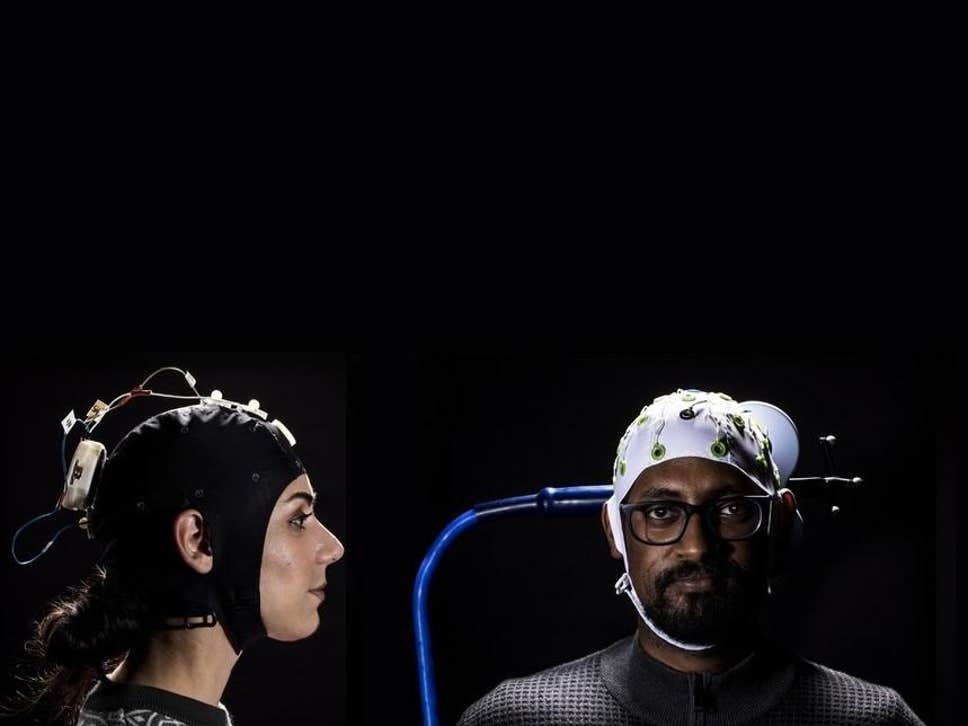
Language — whether it’s spoken, gestured or written — is what allows individuals to express and share their singular thoughts with others. Without language, we might just as well be black boxes. In the future, however, there may be other means of sophisticated communication that directly link the brains of other people, allowing them to communicate with their thoughts alone rather than using language.
The language of the brain
A team of neuroscientists, psychologists, and computer scientists led by a group from the University of Washington in Seattle recently presented BrainNet, “the first multi-person non-invasive direct brain-to-brain interface for collaborative problem-solving.”
Essentially, what this insane project has managed to do is network the brains of three humans so that they could collectively solve a problem: correctly orientating a block so that it would fit in between two other blocks. Two individuals acted as “senders” as they could see the gap and send instructions to a third individual, who served as the “receiver”. The receiving individual was blinded as to make him completely reliant on the senders for the correct solution to the Tetris-like game.
The two senders were equipped with electroencephalographs (EEGs) that recorded their brain activity, then sent to the receiver via a computer interface.
“Humans are social beings who communicate with each other to cooperate and solve problems that none of us can solve on our own,” said Rajesh Rao, a professor at the University of Washington’s Paul G. Allen School of Computer Science and Engineering.
“We wanted to know if a group of people could collaborate using only their brains. That’s how we came up with the idea of BrainNet: where two people help a third person solve a task.”
To make things easier, the senders had to focus their gaze at a high-frequency light source on the screen to signal the instruction to rotate or to focus on a low-frequency light to signal not to rotate. The computer interface transcribed this signal into a magnetic pulse that was delivered to the receiver via a transcranial magnetic stimulation (TMS) device. The pulse caused the receiving individual to “see” a flash of light in their visual field, a cue that the block needs to be rotated. No signal within a determined period of time was the instruction not to turn the block.
Five groups of individuals were tested over the BrainNet network, which achieved 80% accuracy in completing the task after several trials. In subsequent tests, the researchers raised the difficulty up a notch by adding noise to the signal sent by the senders. But, the receiver learned to discern the ambiguous signal from the senders’ instructions — a process that, according to the researchers, emulates some features of conventional social networks.
Previously, other research groups had networked the brains of rats and primates. In one study, three primates were connected to the computer through implanted brain-computer interfaces. They all had to simultaneously move a cursor to a target with their thoughts alone. During this instance, the animals weren’t linked together but rather performed parallel processing, with each brain contributing activity towards the goal while compensating for the lack of activity of others.
At the moment, the researchers’ demonstration on humans is rather limited. You can use the setup only to relay binary “yes” or “no” instructions. It’s possible, however, to send more sophisticated messages using functional magnetic resonance imaging (fMRI). By the same token, the receiver’s transcranial stimulation can be targeted to specific brain regions and networks. But, realistically speaking, this is still very much the domain of sci-fi at the moment.
That being said, the findings are definitely intriguing while raising many philosophical questions. If a human brain is capable of so much creativity and craftmanship, what could a network of two, ten, even a hundred individuals? And with all of today’s controversial debate around online privacy, what should we make of a technology that could someday access our very own thoughts?
The study was published in the journal Scientific Reports.






